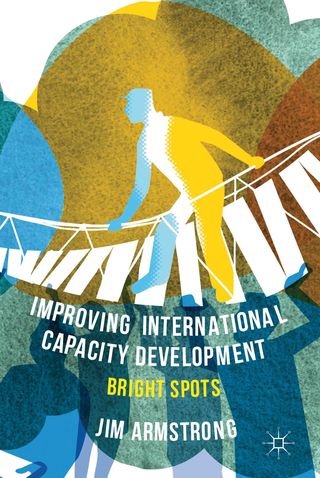Posted by Chris Iles[1]
For many years, Dr. Jim Armstrong has been at the forefront in challenging the commonly held view that “international best practices” provide an effective solution to capacity development in developing countries. He has been particularly concerned that many projects aimed at reforming public administration in poor countries fall short of their objectives, fail to sustain benefits after the project is complete and, by passively importing foreign practices, prevent the development of indigenous solutions.
In a recently published book[2] Dr. Armstrong reflects on the limitations of this standard approach to capacity development, considers why success is often elusive, and articulates a new approach founded on local success rather than imported prescriptions. His ideas should be of interest to academics, practitioners, beneficiaries and promoters of capacity development everywhere. They are relevant for practitioners working in the field of public financial management.
The book presents the fruits of Dr. Armstrong’s many years of field experience at the helm of The Governance Network[3] as well as his independent research. It illustrates key points with extensive examples from diverse parts of the world including Afghanistan, the United Kingdom, Nepal, Somalia, Vietnam, Guyana and the Semiahmoo Indian Reserve in Canada. Further insight is provided by a detailed case study based on his central role in Trinidad & Tobago’s Ministerial Performance Management Framework (MPMF) programme.
The book begins by noting the high failure rate associated with attempts to implement best practices that have been developed in rich, successful donor countries in highly dissimilar states, in different regions, with different cultures and at different stages of development. It notes that the standard model of employing external experts to mechanistically apply a rational scientific approach to assess, plan, implement and evaluate progress towards a pre-determined ideal often does not result in sustainable capacity.
The notion that best practices should be presented in a context-sensitive way with the support of domestic buy-in is no longer a new one. Academics such as Matt Andrews of the Harvard Kennedy School have developed very similar ideas.[4] Nevertheless, success continues to be elusive. Dr. Armstrong suggests that this reflects the nature of “capacity” – a complex, ambiguous, abstract concept – and the fact that capacity-building challenges are intractable, messy, interconnected, and often contradictory. He describes these challenges as “wicked” problems that are not amenable to pre-defined technical solutions. A better approach is likely to be adaptive, novel and risky, and less certain to reach a definite end-point at which a single best outcome is definitively achieved. Put another way, public policy complexity is unlikely to be satisfactorily addressed by engineering-type solutions.
Dr. Armstrong espouses replacing the standard capacity building model with its assumption of linear relationships and simple causality, and actors that are passive and reactive, with a new paradigm that is more robust in the face of societal realities that integrate multiple visions and expectations. His solution is an assertively collaborative approach, with the change agent retreating from the role of expert (i.e., the dominant provider of solutions) and adopting the mantle of coach, guiding the process through which the recipient actors apply their own deep knowledge of local situations, power relationships, and expectations. The book explores a new approach to building capacity that embeds collaboration throughout a non-linear process that combines co-diagnosing, co-learning, co-designing and co-acting to achieve results that are meaningful in the local context.
A key insight in this book is the application of the collaborative method to identifying and adopting positive deviations – the anomalous instances of good outcomes (the “bright spots” referred to in the title of the book) amongst generally negative circumstances. The book presents a striking example of this approach from Vietnam where the development of capacity to provide better child nutrition did not lean on standard external prescriptions. Instead, reformers sought out examples of local children who were well-nourished despite local conditions, identified how this came to be and looked for ways to propagate these observed behaviors to the general population. It is evident that this approach leans heavily on intense local engagement to discover what is already working in the community, and places the external change agent outside the realm of technical expert and into a position of facilitation (a much different and seemingly less common skill set). The end result is less a solution to a technical problem (although that is significant) and more the development of a collective understanding of the issues, in which local actors work together to find a solution to local challenges. This in turn generates confidence amongst the actors in their problem-solving abilities – a key aspect of true capacity.
Dr. Armstrong recognizes that the implications for changing how projects are defined and subsequently evaluated are profound. There are significant challenges that can only be accommodated by upsetting much of the development profession’s current orthodoxy, which will be no small task. At the beginning of the book Dr. Armstrong poses the question: “are there new, emerging approaches to building the capacity of developing country public sector institutions that show more promise than what has been tried in the past?” In answering this question positively, Dr. Armstrong presents cause for optimism that an approach founded on guiding the acquisition of practical wisdom (rather than applying normative solutions), together with identifying and building on “bright spots”, can truly develop capacity where it is most needed.
[1] Technical Assistance Advisor, PFM2 Division, Fiscal Affairs Department, IMF.
[2] Jim Armstrong, Improving International Capacity Development: Bright Spots, 2013, London: Palgrave Macmillan.
[3] The Governance Network is a Canadian consulting firm specializing in governance, organizational renewal and public sector modernization, www.governancenet.com.
[4] Matt Andrews, The Limits of Institutional Reform in Development: Changing Rules for Realistic Solutions, 2013, Cambridge: Cambridge University Press.
Note: The posts on the IMF PFM Blog should not be reported as representing the views of the IMF. The views expressed are those of the authors and do not necessarily represent those of the IMF or IMF policy.




